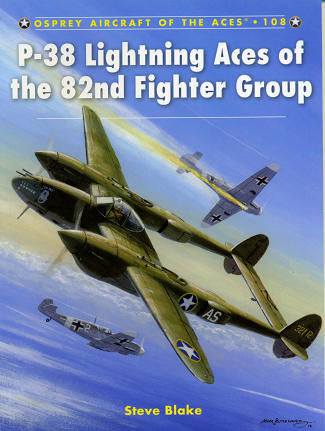 Though not
as much a 'backwater' as the CBI, the Mediterranean theater of operation was not
the main focus of the Allies during WWII. Well, not the main focus of the US,
though it is well known that Churchill thought that a lot more effort should
have been spent there vice northwestern Europe.
Though not
as much a 'backwater' as the CBI, the Mediterranean theater of operation was not
the main focus of the Allies during WWII. Well, not the main focus of the US,
though it is well known that Churchill thought that a lot more effort should
have been spent there vice northwestern Europe.
Anyway, with the North African invasion of late 1942,
the Germans had yet another area of concern, especially following the defeat at
El Alamein just a few days prior. Into that campaign was sent the 82nd Fighter
Group. Initially formed on the P-38 and with a rather high contingent of
sergeant pilots, it was first shipped to England, but very soon it was sent to
North Africa. Much to the displeasure of most crews, what was really needed were
its aircraft to make up for losses with other groups. With most of its planes
now in other hands, they still managed to pull some missions until replacements
arrived in early 1943. By then it was decided that mere enlisted people could
not be fighter pilots in the USAAF so all the sargent pilots were promoted to
2nd Lt. An odd decision since just about all the other warring powers had no
trouble with enlisted pilots, many of whom were quite successful. But I digress.
Flying the 'smooth cowling' P-38 E/F/G models, the 82nd
soon got into the swing of things performing both escort and ground attack
missions, but mostly escorting bombers. Soon pilots started racking up scores
and aces were made. The thing about the Med is that it just wasn't chock full of
enemy aircraft as were other fronts. This was particularly true towards the end
of the war when EA were very rarely sighted and most 'kills' were on the ground.
The 82nd stayed with the P-38 until the end of the war,
eventually getting the much better P-38J, though never having the opportunity to
fight with the even better P-38L, most of which went to the Pacific. Still, the
82nd produced a respectable number of aces as well as pilots who went on to
achieve ace status with other units.
In this book by Steve Blake, we get a good look at the
82nd from inception until the end of the war. Its early days of training in the
US as well as its exploits in North Africa, Sicily and Italy are covered in some
detail. We get to meet the pilots of the unit, read of some of their more
interesting exploits and see period photos of these men and their aircraft.
Typical of the series, the research is very well done, something we have come to
expect from Osprey titles.
It all makes for a great read and thanks to the superb
selection of period photos and the fine collection of
full color profiles, we get a more complete picture of this unit's WWII
operational history, making for an excellent book for the historian and modeler
alike. One that I can easily recommend to you.
September 2012
For more on the complete line of Osprey books,
visit www.ospreypublishing.com. In the US, it is
Osprey Direct at 44-02 23rd St, Suite 219, Long Island City, NY 11101., where you can
get a catalogue of available books.
If you would like your product reviewed fairly and quickly, please
contact
me or see other details in the
Note to
Contributors.
 Though not
as much a 'backwater' as the CBI, the Mediterranean theater of operation was not
the main focus of the Allies during WWII. Well, not the main focus of the US,
though it is well known that Churchill thought that a lot more effort should
have been spent there vice northwestern Europe.
Though not
as much a 'backwater' as the CBI, the Mediterranean theater of operation was not
the main focus of the Allies during WWII. Well, not the main focus of the US,
though it is well known that Churchill thought that a lot more effort should
have been spent there vice northwestern Europe.